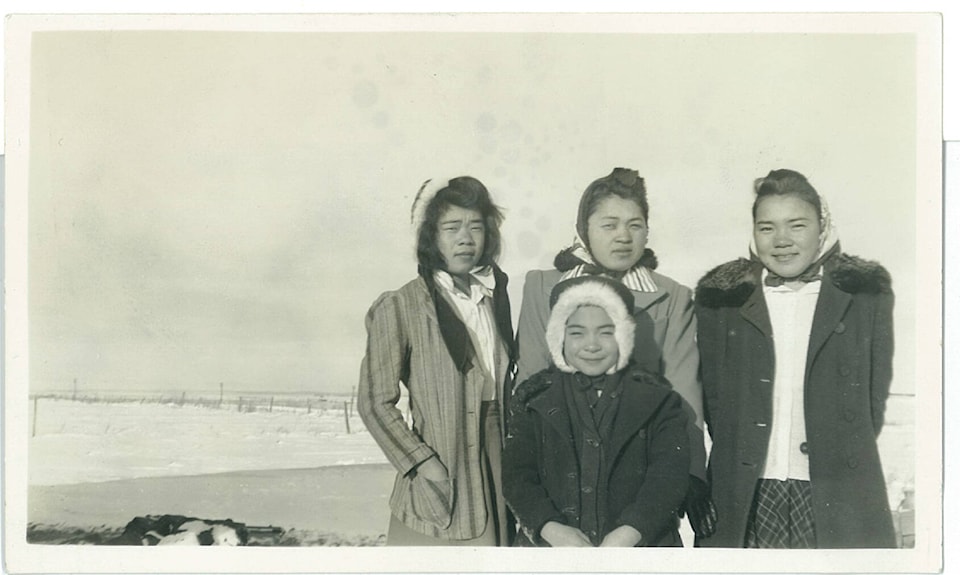A collection of donated of letters between Japanese-Canadians held in interment camps and their Surrey penpal are both hopeful and “emotionally engaging,” and now the University of British Columbia Library is looking to connect with the descendants of those who were forced away.
Tomoko Kitayama Yen, a Japanese studies librarian, and Krisztina Laszlo, archivist for rare books and special collections, have been trying to connect with the family members of those who wrote to Joan Parolin (née Gillis) while in internment camps in northern B.C. and the Prairies. Parolin donated the collection of 149 letters and 10 small photographs to the UBC Library.
Parolin, who attended Queen Elizabeth Secondary during the Second World War, first met Sumi Mototsune, whose father owned a small boat-building yard on the Fraser River, while they attended South Westminster Elementary school in Surrey. Parolin wrote to Mototsune and 12 others after they were sent to internment camps.
“The temperature was 32 below zero. Isn’t it some scenery? Dad took the picture,” reads a letter from Mototsune in Raymond, Alta, which is roughly 1,200 kilometres from Surrey.
One of the letters that Sumi Mototsune wrote to Joan Parolin after she was sent to a Japanese internment camp. Mototsune and Parolin, who first met in school in Surrey, became pen pals after Mototsune was forced to leave. (Submitted image: UBC Library)
According to the archive description, “In the wake of World War II and the Japanese attack on Pearl Harbor, Gillis watched as her friends of Japanese Canadian descent were ordered, along with their families, to be interned away from the ‘security zone’ of within a 100-mile radius of the coastline.
“Gillis and many of her classmates felt that this was unjust, and in 1942 she began regular correspondence with several of her Japanese Canadian friends and acquaintances.”
The letters, according to the library, “provide insight into the Japanese-Canadian internment, which occurred against the backdrop of a larger cultural context” of racially targeted legislation that included limits on immigration, fishing licences and being denied the right to vote.
After Japan attacked Pearl Harbor on Dec. 7, 1941, Canada declared war on the country. The following year, approximately 22,000 Japanese-Canadians in B.C. were forced into internment camps.
After the war, Laszlo said, not very many Japanese-Canadians came back to B.C. “because they essentially had nothing to come back to. All of their property, their livelihood, their social networks, all of that had disappeared.”
In order to finance sending them to the camps, the federal government “confiscated their agricultural property and personal possessions and allowed them to be auctioned off or sold at low prices,” according to the Legislative Assembly of B.C.
Kitayama Yen, who described herself as a new immigrant, said while she doesn’t share the same history as these families they’re searching for, she has the same heritage.
“I really have an interest in getting to know more about their history and their stories and it’s been an amazing, eye-opening journey for me as well. These people who have responded have been so generous and shared stories and their insight as we communicated.”
So far, they have been able to make contact with families of nine of the 13 letter writers, but they’re still looking for the families of Akira Fujii, Emee Otsuki, Leo Otsuki and Masao Ujiiye.
Laszlo said making these connections has been a real eye-opener for the family members, as “there’s now this really deep insight” into their family.
“There’s been this opportunity in a way to get to know that person from their family that they wouldn’t have otherwise seen that side of them,” Laszlo said. “Everybody was a teenager, they were all junior high, high-school-age kids and they were writing as kids write when they’re 16, 17, 15 years about things that matter to kids of that age.”
Laszlo added they’re always asking themselves, “‘Well, what did Joan write back?’”
“We have clues from the letters. She would send gifts, seeds, photographs, copies of the school newspaper, all sorts of things. So she was a real source of connection to the lives these kids had been forced to leave behind.”
While Kitayama Yen noted that some of the letters were full of hope, “there’s this sort of sadness there.”
“They’re trying to protect Joan because you can’t share everything,” she said. “Everytime I see it, read it, I’m in tears. I just can’t help it. It’s so emotionally engaging.”
If you think you might be one of the family members of the four remaining letter writers, email tomoko.kitayama@ubc.ca.
lauren.collins@surreynowleader.com
Like us on Facebook Follow us on Instagram and follow Lauren on Twitter
